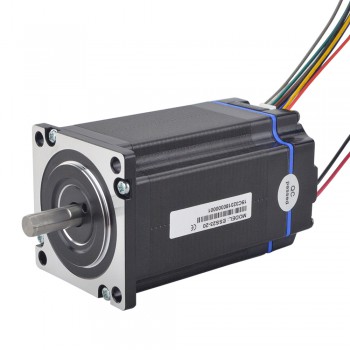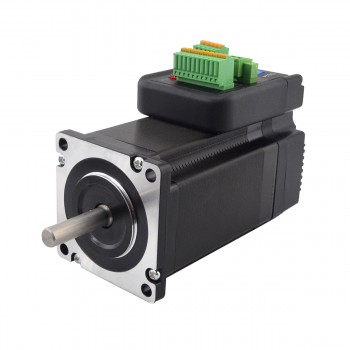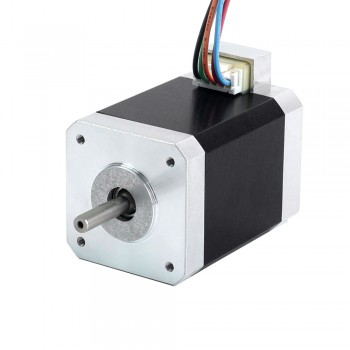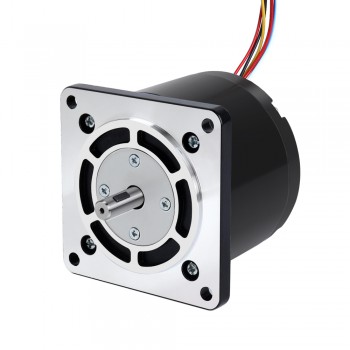1.Definition of integrated servo motor
Integrated servo motor is a motor that integrates servo motor and driver. It has the characteristics of compact structure, easy installation and fast response speed. The integrated servo motor has a servo driver integrated inside it, which can directly receive signals from the controller and perform corresponding actions. Compared with traditional split servo motors, this design reduces the number of external connecting parts, further simplifying the installation and maintenance process of the system. In addition, due to the integrated design, the integrated servo motor also has significant advantages in performance, such as higher accuracy and faster response speed, thereby improving the overall performance and reliability of the system.
2.Components of integrated servo motor
1.Motor part: including rotor, stator, windings, magnetic poles and other components. There are various types of motors, such as DC servo motors, AC servo motors, stepper servo motors, etc. Each type of motor is different in structure and control method.
2.Sensor part: usually includes position sensor, speed sensor, torque sensor, etc., which are used to detect the position, speed, torque and other parameters of the motor in real time, and feed the detection results back to the control system for real-time adjustment.
3.Controller part: Usually composed of a control chip, amplifier, encoder, etc., used to receive parameters fed back by sensors and output control signals to the motor to control and adjust the position, speed, torque and other parameters of the motor. .
4.Power supply part: Usually composed of power transformer, rectifier, filter, etc., used to provide stable power supply voltage and current to ensure the normal operation of the motor.
5.Mechanical part: Usually composed of reducers, couplings, transmission devices, etc., used to convert the rotational motion output by the motor into linear motion or other specific motion forms to meet different application requirements.
3.Operation mode of integrated servo motor
1.Position mode: This is the most commonly used control mode for servo motors. The host computer sends high-speed pulses of a certain frequency and cooperates with the direction signal to realize the forward and reverse rotation of the motor. By adjusting the frequency of the pulses, the speed of the servo motor can be changed. The core of the position mode is the position closed-loop control system, which consists of position sensors, controllers, drives and motors. It uses PID control algorithm to achieve precise control of the motor position by adjusting the proportional coefficient, integral coefficient and differential coefficient. Position mode is widely used in situations that require precise positioning, such as CNC machine tools, robot joints, automated assembly lines, etc.
2.Speed mode: Speed mode uses analog quantities to control the rotation speed of the motor. Although speed mode has fewer applications because it can control speed with the same accuracy as position mode, it still has its uses in certain specific applications. The core of speed mode is the speed closed-loop control system, which consists of speed sensor, controller, driver and motor. It also uses PID control algorithm to eliminate speed deviation and make the motor shaft run at a constant or changing speed.
3.Torque mode: Torque mode is usually used in constant voltage control to control the output torque of the servo motor through analog quantities. This mode is combined with the position mode for closed-loop control, and the effect is more ideal. The control of torque mode is more complicated, and it is necessary to detect the output current of the servo drive and perform torque control based on the current feedback signal.

4.Application scope of integrated servo motor
1.Industrial automation: Integrated servo motors play a vital role in the field of industrial automation and are widely used in robotic arms, conveyors, assembly lines and other equipment. They realize efficient production processes and improve production efficiency and product quality through precise position control and motion control. The fast response and precise position feedback capabilities of servo motors enable it to adapt to complex industrial environments and task requirements.
2.Robot technology: Servo motors are an ideal choice for robot joint drive. They can provide high-performance power output and flexible motion control to meet the different needs of robots in various industries, services and special environments. In fields such as automated production lines and logistics warehousing, servo motor-driven robots can achieve efficient operations and automation tasks.
3.CNC machine tools: Integrated servo motors are widely used in CNC machine tools, which can achieve precise motion control and position control, provide high-speed, high-precision working performance, and meet the needs of modern manufacturing for equipment automation and intelligence.
4.Medical equipment: Servo motors are widely used in various medical equipment, such as medical robots, imaging equipment, surgical instruments, etc. The high precision and reliability of servo motors play a vital role in medical equipment, ensuring the stability and safety of medical equipment.
5.Aerospace: In the field of aerospace, servo motors are widely used in the steering gear system of aircraft to achieve attitude control and flight stability of the aircraft by controlling the rudder surface of the aircraft. The rapid response capability and precise control capability of the servo motor enable the aircraft to achieve various complex flight movements, ensuring flight safety and stability2.
In addition, integrated servo motors are also used in medical equipment, 3D printing, textiles, printing and other industries. With the continuous development of technology, its application scenarios will continue to expand, providing more efficient and accurate solutions for various industries.
Source:https://www.steppernews.com/2024/08/operation-mode-of-integrated-servo-motor.html


